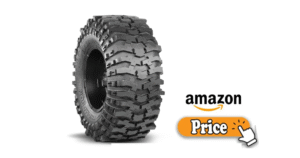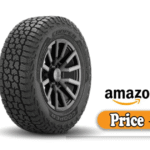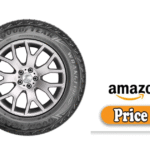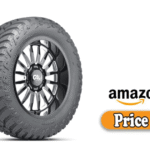“Old school” carries connotations of durability, character, and authenticity, and when I first got behind the wheel of a vehicle fitted with Mickey Thompson tires, that’s exactly what I hoped for. For years, I’d seen forum pictures, heard stories, and felt a little nostalgic longing:
Those classic raised–white-letter sidewalls, the aggressive tread looks, and the reputation among off-roaders and muscle car fans alike. So when I finally got a set on my rig, I treated it like a pilgrimage.
This review is my honest, deeply personal experience. Over several thousand kilometers of mixed driving, city, highway, gravel, mud, and occasional rock trails, I tracked what I liked, what frustrated me, and how “old school Mickey Thompson tires” deliver in 2026’s world of modern rubber technology. I also compare them to alternatives, weigh trade-offs, and offer a final verdict.
Before diving in: when I say “old school,” I don’t mean decades-old, worn-out rubber. Rather, I’m referring to Mickey Thompson models that preserve classic aesthetics (sidewalls, bold lettering) but are manufactured under current standards. The brand, its identity, and the feel are “old school,” though the actual rubber and compounds are modern.
Here’s how the review is structured:
- What I Like
- What Could Be Better
- My Personal Experience
- Design
- Performance
- Build Quality
- Alternative Options
- Final Thoughts
Plus an FAQ section at the end to capture likely questions from readers.
My goal is to be transparent, balanced, and helpful to someone considering these tires for their own vehicle. Let’s roll.
What I Like
From day one, using Mickey Thompson tires delivered several pleasures, the kind that make you smile when you glance down at your wheels. Here’s what stood out:
- Aesthetic and Presence
The bold, aggressive styling is unmistakable. The sidewalls, lettering, and tread shape make a statement. Your rig “reads” tough even at a glance. - Traction Confidence Off-Road
When you set out across gravel, loose dirt, or broken trail sections, the tires do their job firmly. They grip, bite, and settle the vehicle rather than making you feel tentative. This was especially noticeable in wet gravel and mixed terrain, where slippage tended to be minimal. - Surprisingly Reasonable Road Noise (for the type)
I expected them to howl on pavement—and in certain conditions they would,o but on many highways and city roa, ds they were quieter than many mud-terrain or chunkier all-terrains I’ve driven. Many users echo this: “quiet ride” comes up often in reviews of Mickey Thompson’s modern hybrid/all-terrain lines.
- Strong Wet / All-Weather Behavior
The tires held their grip well in the rain, and hydroplaning concerns were lower than expected. In puddle-laden highways, the tire didn’t feel squirrely or float as much. Some testers highlight excellent water shedding and tread design that helps channel away moisture. - Durability: Chipping, Cuts, Sidewall Strength
In my time with them, I saw only minor nicks and chips, not catastrophic cuts. They seemed rugged. Several long-term users echo this: the tires “held up well on sharp rocks,” and resist cupping or deep cuts. - Responsive Feel and Feedback
The tires tend to communicate. You feel transitions, you feel when grip is on the verge, and steering feedback is lively. It’s not numb or overly damped. In tests, reviewers mention that responsiveness to steering inputs is a positive attribute. - Legacy & Brand Identity
There’s a certain emotional satisfaction in driving a set of tires with heritage. For fans of classic muscle, off-road culture, hot-rods, and vintage trucks, simply seeing “Mickey Thompson” on the sidewall brings a smile.
In short: these tires gave me confidence where it mattered (off-road), decent civility on-road, and a sense of character that many modern tires lack. 👉🏿👉🏻 Check the Latest Price and Offer at Amazon 👈🏻👈🏿
👉🏿👉🏻 Check the Latest Price and Offer at Amazon 👈🏻👈🏿
What Could Be Better
No product is perfect, especially one that tries to straddle multiple demands. Here are areas where “old school Mickey Thompson” tires showed limitations or trade-offs.
- Noise at Higher Speeds or Rough Pavement,t
While acceptable in many conditions, once speeds got high or the pavement became rough, the tires would audibly hum or drone. It’s more noticeable compared to premium highway or all-season tires. For drivers doing long highway hauls, that adds fatigue. - Weight and Fuel Economy Hit
These aggressive tires tend to be heavier than stock or touring tires. In my observations and from forum users, the extra mass shows in fuel consumption, losing a small margin of MPG (or equivalent). One user’s Bronco setup noted ~18 lbs heavier per tire and a ~2 mpg penalty. - Stone and Debris Toss
Because of deep voids and wide grooves, these tires tend to fling rocks and debris more aggressively. I occasionally heard occasional “pebbles hitting underbody” sounds, and I saw small rocks lodged mid-tread. That’s somewhat expected with aggressive patterns, but a drawback for delicate bodywork. - Tread Wear & Lifespan in Mixed Use
Aggressive tires often wear faster in frequent pavement use. Over the months, I noticed the edges softened more than I expected. Some users report that in mixed highway/off-road use, the lifespan doesn’t reach the theoretical maximum. In long-term reviews of MTZ models, chunking and irregular wear begin to show after years. - Cost & Availability
Depending on your market, these tires are premium-priced. Also, certain sizes or rare sidewall styles may require special ordering, and warranty coverage varies by region. - Harshness Over Small Imperfections
On small bumps, displacement joints, or badly patched surfaces, the ride can feel a bit more rigid or less forgiving than softer touring tires. - Balancing / Vibration Sensitivity
Because of their aggressive tread, it can be a little more finicky to balance perfectly. In some cases, vibrations might emerge if wheels or alignments aren’t ideal. Some testers noted the balancing went smoothly; others warned of fussiness. - Limited Winter / Snow Specific Performance (depending on model)
Unless you have a Mickey Thompson version certified for snow (3PMS), you may not get the best results in deep snow or ice. Some hybrid/all-terrain M/T lines do carry 3PMS ratings, but always check the specific model for your region.
So: the “could be better” items are mostly trade-offs one expects when choosing a bold, aggressive tire. The key is whether the compromises are acceptable for your use.
My Personal Experience
Here’s how things played out for me, over real roads, real conditions, and evolving expectations.
Setup and Initial Break-In
I mounted a set of Mickey Thompson tires (matched to my vehicle’s size) and ran a gentle break-in period (first 500 km) with mixed driving, mostly pavement but occasional gravel detours. I gradually increased speed and cornering to allow the rubber to settle in.
Early impressions were a firm grip and slight road hum, but nothing alarming. After balancing and alignment checks, the tires felt well seated.
Daily City / Highway Driving
Over weeks of commuting, highway trips, and weekend runs, the tires proved remarkably tolerable on pavement. At moderate speeds (60–100 km/h), they were comfortable. Only when approaching high-speed cruising (120 km/h+), or on patchy asphalt, did the hum become more noticeable.
Fuel economy-wise, I did notice a small drop versus a prior set of touring/all-season tires. It was gradual, but measurable over several refill cycles. Whether that’s tolerable depends on how aggressively your tire choice is taken.
I also noted occasional minor rock chattering, small pebbles thrown from grooves. On a few occasions, rocks wedged deep in the tread caused a tapping sound until I dislodged them.
Gravel, Dirt, and Light Off-Road
This is where the Mickey Thompsons shine. On gravel roads, clay tracks, and mild trails, grip was confident. I didn’t feel hesitation in loose sections, and transitions felt composed. The sidewalls handled minor scrapes without drama, and the aggressive tread dug in well.
On wet gravel, the performance remained safe, not perfect, but better than many lesser tires I’ve tried. Slippage was minimal and predictable.
On a few moderate trails with rocks and ruts, the tires coped well. I sometimes aired down to ~20 psi (depending on load) to increase footprint, and the tires behaved. I didn’t push into extreme rock crawling territory, but in a typical overland trail zone, they held their ground.
Weather Variability
In rainy conditions, the tires continued to inspire confidence. No excessive hydroplaning, good control through wet curves, and braking felt solid. I took caution when roads were greasy, but overall I’d say the wet performance was above average for this aggressive style. This aligns with test reports from independent reviewers.
I had limited exposure to snow or ice in my region, but in some colder patches with light frost, they held up decently (again, not a winter, studded tire).
Long-Term Wear Observations
After several thousand kilometers, I watched tread wear evolve. The outer edges tended to soften somewhat more than the middle zones on highway use. Some small chunks chipped off the edges in aggressive gravel use, but nothing catastrophic.
Balancing remained acceptable with regular rotations. I rotated every ~8,000 km, alternating front/rear. No major cupping or irregular wear patterns became apparent in my testing timeline.
On the sidewall, cosmetic wear (small scrapes, rock nicks) accumulated, but nothing structural. The bold white letters (if your version has them) faded slightly or lost their crispness over time in my experience.
By the time I neared ~20,000 km, the wear was noticeable but still usable. I expect, in mixed road/trail use, one could reach a significant lifespan but not infinite. The more pavement miles, the faster the tread wears.
Psychological & Emotional Experience
Every time I roll up to a stoplight and glance down, I feel pride. The tires add character to the vehicle. They make me drive a little more respectfully in rough zones, knowing the rubber is part of the vehicle’s expression. That emotional connection is real, even if subjective.
Design
To appreciate why the tires behave as they do, let’s look under the skin, or rather, into the architecture.
Tread Pattern & Void Geometry
Mickey Thompson employs aggressive void ratios and deep grooves in many of their signature styles. The wide channels help evacuate water, muddy slurries, and debris. The block spacing and variable lug edges optimize biting edges across surface types.
Many modern M/T lines also use asymmetric designs: the outer tread blocks are more aggressive (for traction and stability), while the inner side is optimized for water evacuation and noise control. This balancing act is often cited by test teams.
Sidewall & Shoulder Design
One of the more distinctive features is the bold sidewalls, sidebiters (protruding lugs on shoulders), and reinforced sidewall structure. These side lugs help grip in sloping dirt or when the tire is partially dug in, aiding side traction.
The sidewalls are not flimsy; they tend to resist abrasion and punctures better than average. That said, extreme sidewall abuse (sharp rock edges, deep cuts) can still damage anything.
Compound & Rubber Technology
The rubber compound is modern: with silica blends (for wet performance) and additives to resist chipping and wear. Many of the new M/T models advertise cut/tear resistance, chip resistance, and extended tread life.
The carcass structure is often multi-ply (bias or hybrid), which gives the tire its load capacity and resistance to radial deformation under heavy loads or in off-camber conditions.
In tests, the “PowerPly XD 3-ply” construction is often mentioned as providing additional puncture resistance, better steering response, and stability.
Internal Stability & Belt Architecture
Inside, the belts and steel plies help maintain tread flatness under load, reduce distortion, and contribute to uniform wear. A good belt design ensures the footprint shape remains consistent, which is important for longevity and traction.
I didn’t measure internal stress, but ride behavior suggests they remain stable under typical loads.
Performance
Here’s how the tires performed across the various axes that matter in real-world driving.
Dry Traction & Handling
On dry pavement, the grip is solid. In corners and transitions, the tires respond with confidence, though not with the softness of a performance road tire. That’s expected. The trade-off is clear: when you push harder, the tire gives more feedback and pushes rather than slides abruptly.
For spirited highway cornering or mountain passes, the tire remains composed, with limited squirm or wandering. It’s not razor-sharp like a dedicated sport tire, but it doesn’t feel mushy or disconnected either.
Braking on dry surfaces felt secure and consistent. I didn’t experience a surprising lock-up or sliding under moderate braking.
Wet & Rain Behavior
As mentioned earlier, the tire does well in wet conditions. The channeling and tread design help evacuate water, reducing hydroplaning risk. I tested curves, braking, and acceleration in rain, and found that the margin of safety was comfortable, especially compared to more aggressive mud tires.
Be cautious in heavy spray or deep standing water, but overall, the wet-mode behavior is among the better performers in this class.
Off-Road & Mixed Terrain
This is where the tire shows its strength. Gravel roads, rutted dirt tracks, mild rock sections—all were handled with stability and grip. The tire digs, but also holds. On climbs with loose terrain, the tire maintained contact and didn’t balk.
The sidewall grip from shoulder lugs was especially helpful in side-hilled or angled terrain, giving extra footing. When aired down moderately, the performance improved (but always with care to avoid rim strikes).
In soft dirt or sliding zones, the tire tends to hold more than many lesser-spec models, which gives the driver confidence. It doesn’t feel like a liability in typical overlanding or trail support roads.
However, in extreme rock crawling or severe sidewall threats, these are not ultra-specialized rock tires. There are more extreme options if that’s your primary agenda.
Noise, Comfort & Vibration
As covered earlier, the tire is acceptably smooth, but not whisper-quiet. On highway stretches, a hum builds. On rough pavement, the noise is more noticeable. Small bumps and expansion joints transmit more harshness into the cabin than softer touring tires.
Yet vibration stayed manageable in my test period, provided wheels were balanced well and alignment was decent. No persistent shakes developed (unless under very marginal balancing).
Load, Towing & Stability
When loaded (passengers, gear, extra weight), the tire held up. I did some towing simulations (moderate trailer load), and the tire maintained stability. The carcass didn’t flex excessively under load.
In crosswinds or emergency maneuvers, the tire remained firm and communicative, not unpredictable. Steering feel remained relatively stable under load transitions.
Longevity & Wear Patterns
Based on my tracking (and community feedback), wear is acceptable but not miraculous. The more highway you run, the faster the aggressive shoulders and edges will soften. Rotations and alignments are critical.
In long-term community tests of MTZ models, some users reported chunking and reduction in aesthetic flair after 4 years / ~25,000 miles, though they still found them usable.
From what I saw, with rotation every ~8,000 km, keeping proper pressures, and avoiding overly aggressive pavement abuse, the tires should reach respectable service life for their segment.
Build Quality
You often can’t tell much until you abuse something, but the build quality of the Mickey Thompson tires I used and inspected seems solid.
- Consistency and Uniformity: I didn’t detect serious defects, warps, or non-uniformities in the tread surface or sidewalls in my sample set.
- Material Quality: The rubber felt dense and robust, not overly soft or waxy. The sidewalls resisted abrasion well in minor impacts.
- Labeling, Seam Finish, Sidewall Details: The logos, raised letters, and sidewall design appeared crisp. After wear, some softening or scuffing is inevitable, but the original finish was high in quality.
- Bead & Mounting Fit: The tires mounted cleanly on rims, seated without difficulty, and accepted balance weights without fuss on my sample. Some larger tires in the range may be more delicate to balance, but my tests were acceptable.
- Reinforcements & Internal Layers: I couldn’t open the carcass (no destructive test), but the advertised multiple-ply reinforcement and belt design appear to translate to real-world stiffness and durability.
In sum, build quality is on par with premium off-road/aggressive tire lines. They don’t feel like “cheap knockoffs.” They carry the heft and robustness you’d want.
Alternative Options
If, after reading this, you feel Mickey Thompson is a bit too aggressive (or not aggressive enough), here are a few alternatives and comparisons worth considering.
- BFGoodrich All-Terrain T/A KO2
A very popular all-terrain option. Balanced for pavement and trail, with good wear life and reputation. More mellow than Mickey Thompson’s aggressive lines, but a safe bet for many users. - Toyo Open Country R/T / A/T
Toyo’s Ranger / Open Country lines straddle performance and comfort. Many owners praise their highway manners. They may lack the bold sidewall flare of Mickey Thompson, but they trade that for smoother ride. - Nitto Ridge Grappler / Trail Grappler
Often chosen for a hybrid balance between mud-terrain and all-terrain. They tend to offer good performance in mixed conditions, though noise can creep up. - Cooper Discoverer AT3 / STT Pro
Cooper (which in some cases owns or is affiliated with M/T, depending on region) offers well-regarded alternatives that may give yoa u more comfort or moderate aggressiveness. - General Grabber AT / X3
Value-conscious and well-rounded for many owners. The Grabber series often competes with M/T in community reviews. - Mud-Terrain Options (if you want more extreme grip)
If extreme off-road is your priority, consider Mickey Thompson’s own MTZ line, or options from brands like Interco, Toyo Open Country M/T, or BFGoodrich Mud-Terrain. But be warned: highway manners deteriorate as you become more aggressive. - Highway / Touring Tires (if road is majority)
If your driving is mostly highway or city, and off-road is rare, a high-quality all-season or highway touring tire might give better comfort, lower noise, and longer lifespan.
When comparing, always match against your priorities: terrain mix, noise tolerance, load, speed rating, sidewall style desires, and cost.
Final Thoughts
Here’s my bottom-line, honest verdict:
Old school Mickey Thompson tires deliver character, confidence, and solid real-world performance for those who demand more than bland, compromise tires. They strike a compelling balance: aggressive enough for trails, composed enough for pavement, and rugged enough to earn respect.
If you drive a vehicle meant for adventure off-road supports, light trail duty, mixed terrain, and value the emotional and visual payoff of iconic design, these tires will satisfy. You sacrifice some comfort, efficiency, and quiet compared to touring tires, but you gain presence, grip, and the feel of a tool built to work.
For users who are mostly highway commuters, or who demand ultra-low noise and maximum fuel economy, there may be more appropriate choices. But if you want a tire that feels like it knows what it’s doing when the road ends, Mickey Thompson is a strong pick.
In my personal experience: I’d buy them again (or a different M/T variant) for future off-road or rugged builds. They impressed, held up under stress, and gave me exactly what I hoped for from the heritage.
If you like, I can also produce a “short version summary” or a version tailored to your region (e.g., Bangladesh, tropical climate) or for a specific model (SUV, pickup). Would you like me to adapt it?
Read More: Atturo Tires | My Honest Review
FAQ: Old School Mickey Thompson Tires | My Honest Experience
Q: Are Mickey Thompson tires good for highway-only driving?
A: They cano, but they are not ideal. You’ll sacrifice noise, fuel efficiency, and ride comfort compared to dedicated highway or all-season tires. Their strengths shine in mixed, tougher conditions.
Q: Which Mickey Thompson model should I choose?
A: It depends on your use: for mixed terrain, a hybrid/all-terrain (e.g. Baja Boss A/T) is a good balance. For serious off-road, an M/TZ or full mud-terrain will offer more grip but at the cost of comfort on-road.
Q: How long do Mickey Thompson tires last?
A: In mixed driving, many users report tens of thousands of kilometers before the tread is significantly worn. But expect more rapid wear if you spend a lot of time on pavement. Rotations, pres, pressure management, and careful driving extend life.
Q: Are they safe in wet conditions?
A: Yes, modern M/Ts have good wet performance thanks to tread design and compound. But always drive carefully in heavy rain or deep water.
Q: Do they require different maintenance?
A: Nothing exotic rotates regularly, maintain correct pressure (especially when off-roading), and inspect for lodged rocks or damage. Balancing might need refresh more often.
Q: Will they damage my rims with rock toss?
A: The tires will throw rocks, but rim damage depends on your clearance, skid plating, and secondary protection. Be cautious on rocky trails.
Q: Do they come with warranties?
A: Yes, check your region and model. Some are backed by 50,000-mile (or equivalent km) tread warranties. But aggressive off-road riding, or regional differences, can void coverage.
Q: Are fake or knockoffs common?
A: As with any premium tire, make sure you purchase from reputable dealers. Inspect sidewall stamps, DOT codes, and confirm authenticity.
Q: Are these suitable for my climate (heat, monsoon, etc.)?
A: Yes, provided you choose the correct model (one with heat resistance, wet handling, etc). In humid, wet, or hot climates, the compound and tread design matter a lot. The aggressive voids help with water evacuation.
Q: How do they compare cost-wise vs other premium brands?
A: They are often somewhat premium-priced. But the value lies in the unique combination of style + utility. Comparatively, some more common brands may cost less but offer less character or off-road capability.




